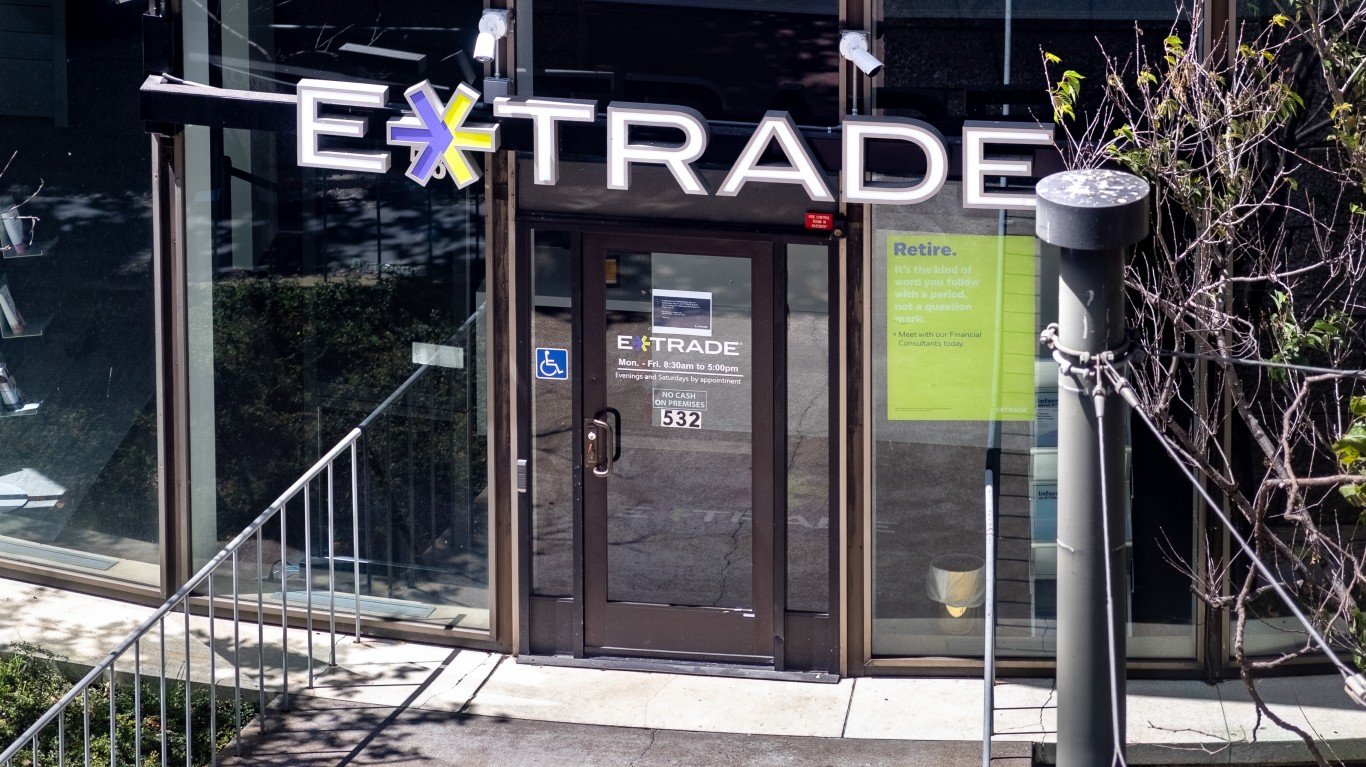Now that most of the financial giants have reported their second quarter earnings, 24/7 Wall St. wanted to pay close attention to the bargain bin that may still attract the value investors. As it turns out, there are 7 big banks still trading under their stated book value per share. Source: Thinkstock
Source: Thinkstock
It may be no surprise for many investors that Bank of America Corp. (NYSE: BAC) and Citigroup, Inc. (NYSE: C) were on the list, but there are 5 other key banks trading at a discount to book value. On a regional basis this number would have been far greater had the smaller regional and community banks been included. These are the banks, that are actual retail banks with depositors and the minimum market cap was $2 billion in order to keep small and illiquid banks from being included.
Regions Financial Corporation (NYSE: RF) and First Niagara Financial Group Inc. (NASDAQ: FNFG) both remain priced at a discount to its stated book value, followed by the following banks: Zions Bancorporation (NASDAQ: ZION); Susquehanna Bancshares, Inc. (NASDAQ: SUSQ); and Hancock Holding Company (NASDAQ: HBHC).
24/7 Wall St. has decided to run a brief analysis and show financial data on each of these banks. We included the market caps and the current share price versus book value per share. Also included were other financial data, dividends, some analyst upside (or downside) target prices, and color on what is holding the values down. One of these banks is actually about to have its buyout close, which might make some wonder if other book value discounts are attractive to value investors.
Bank of America Corp. (NYSE: BAC) is too large—by total deposits, balance sheet, and with its $186 billion market cap—to be acquired. Still, the $17.75 share price of late compares to book value per share of $21.91 stated and $15.02 tangible. The ongoing reviews have been an issue, and there has been a recent executive shuffle as the bank wants to be better positioned to negotiate with regulators.
Shares of Bank of America were down 0.8% at $17.75 late on Monday. BofA has a consensus analyst price target of $19.03 and a 52-week trading range of $14.84 to $18.48. BofA’s dividend yield of 1.1% is still very restricted under its Federal Reserve reviews, but the bank has been buying back stock.
Citigroup, Inc. (NYSE: C) has a market cap of $175 billion. Even if its large base of assets and deposits were not too big to be acquired, it still has so many foreign operations in so many businesses around the world that it might be too complicated for another bank to acquire. Citigroup shares were down 0.9% at $58.19 on Monday, against a 52-week trading range of $46.60 to $60.95 and versus a consensus analyst price target of $64.80.
While Citi’s dividend is a paltry 0.3% yield, it has finally gotten out from under its Fed review and is expected to keep raising that dividend ahead. Citi’s book values per share were $68.28 on a stated basis and $59.18 on a tangible basis as of June 30.
Regions Financial Corporation (NYSE: RF) was just trading at $10.42 with a market cap of almost $14 billion. It screens out as trading at 0.88 times its stated book value, but the tangible book value per share was last shown as being $8.37 per share.
Regions said that its latest ending loans were up 5% to $80 billion, while its average deposit balances were up 4% to $97 billion. Regions has a network of roughly 2,000 ATMs and nearly 1,700 banking offices in the following states: Alabama, Arkansas, Florida, Georgia, Illinois, Indiana, Iowa, Kentucky, Louisiana, Mississippi, Missouri, North Carolina, South Carolina, Tennessee, Texas, and Virginia.
Regions talked about higher loan balances and an increase in non-interest income helping out in the quarter. Its stock has a 52-week range of $8.59 to $10.87, a consensus analyst price target of $11.26, and a dividend yield of 2.3%.
ALSO READ: 6 Oil Stocks Analysts Want You To Buy Now
Zions Bancorporation (NASDAQ: ZION) was just trading at $31.00 with a $6.3 billion market cap. Its stated book value per common share was $32.03 and tangible book value per common share was $26.95 at the end of the second quarter. Zions has a 52-week trading range of $23.72 to $33.03 and a consensus analyst price target of $34.19. The company has a dividend yield of 0.8% due to it having more restrictions than other banks.
Zions has well over 400 bank locations throughout Arizona, California, Colorado, Idaho, Nevada, New Mexico, Oregon, Texas, Utah, Washington, and Wyoming. Its deposits were almost $49 billion at the end of June.
During the second quarter, Zions sold the remaining portfolio of its collateralized debt obligations and took a one-time pretax loss of approximately $137 million. Zions also said that its total loan growth was the major soft spot of the quarter, and the bank warned that the effects of the energy price decline are not yet fully manifested.
First Niagara Financial Group Inc. (NASDAQ: FNFG) was recently trading at $9.55 with a $3.4 billion market cap, and its book values per share were listed as $10.77 on a stated book value and $6.77 tangible book value per common share. First Niagara shares at $9.55 are actually above the consensus analyst price target of $8.85. Still, Jefferies recently gave it a $10.50 price target. The stock has a 52-week trading range of $7.00 to $9.86.
First Niagra has a dividend yield of 3.3%. The company recently said that its 2015 Dodd Frank Act Stress Testing results validate the low risk nature of its balance sheet and support its capital management strategies. First Niagra had roughly 400 bank branches in the Northeast and is sometimes reviewed as a potential buyout candidate despite its own acquisition of NewAlliance in recent years.
Susquehanna Bancshares, Inc. (NASDAQ: SUSQ) is being acquired by BB&T Corp. (NYSE: BBT) in a deal expected to close in the coming days, which ought to make some eyes look at the discounts here. At $14.26 with a $2.6 billion market cap, its stated book value per common share was $15.27 at the end of its second quarter but the tangible book value per common share was down at $8.15.
Susquehanna represented that it had solid loan growth with strong asset quality, and also that its capital ratios are continuing to build. Its total deposits increased $224 million or 1.6% from March 31, 2015 to $14.0 billion at June 30, 2015. Its 52-week trading range is $9.00 to $14.64 and its last dividend yield was 2.5%. The company has a market cap of $2.6 billion.
Hancock Holding Company (NASDAQ: HBHC) was recently trading at $28.33 with a $2.2 billion market cap. Its second quarter book value per share was listed as $31.12. While that is still a steep discount, the tangible book value per share was down at $21.63. Hancock’s 52-week trading range is $24.96 to $35.67, and it has a consensus analyst price target of $31.00 and a dividend yield of 3.4%.
Hancock talked up its second quarter earnings and also talked up the improved quality of earnings. Hancock’s shares have been stuck a range mostly between $27 and $35 for the last five years. The bank said that it has been disclosing its focus on strategic initiatives to replace declining levels of purchase accounting income from acquisitions with improvement in core income. It further noted that the impact to its bottom line from net purchase accounting items has substantially diminished, and that the core results are now equal to operating results.
Some investors may not know this bank holding company. Its footprint is about 235 banking and financial services offices throughout Mississippi, Texas, Louisiana, Florida, and Alabama under the brand names Hancock Bank and Whitney Bank.
ALSO READ: Why GE Outshines 3M and United Tech After Earnings
********
Investors should pay attention to the stated book value versus the tangible book value. A stated book value is what the company would expect on a normalized basis, while the tangible book value per share is what common holders should expect to receive if the bank decided to liquidate immediately.
Sponsored: Attention Savvy Investors: Speak to 3 Financial Experts – FREE
Ever wanted an extra set of eyes on an investment you’re considering? Now you can speak with up to 3 financial experts in your area for FREE. By simply
clicking here you can begin to match with financial professionals who can help guide you through the financial decisions you’re making. And the best part? The first conversation with them is free.
Click here to match with up to 3 financial pros who would be excited to help you make financial decisions.
Thank you for reading! Have some feedback for us?
Contact the 24/7 Wall St. editorial team.



